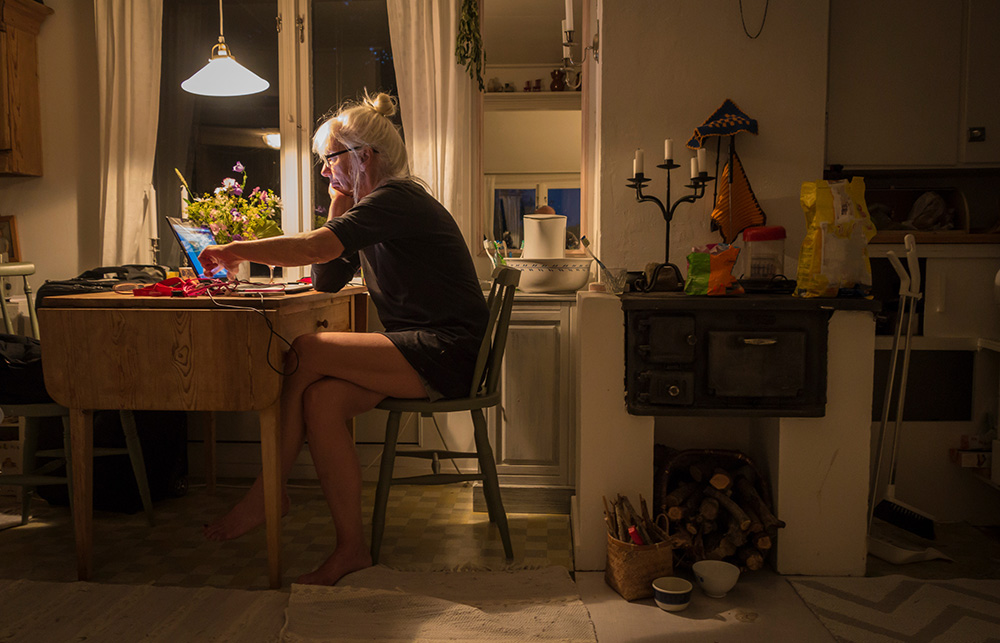
幾年前,當(dāng)我作為一名外部顧問(wèn),,在一家全虛擬公司的年會(huì)上主持一個(gè)時(shí)間管理研討會(huì)時(shí),,我注意到了一點(diǎn):這些人工作量很大。時(shí)間日志記錄了深夜還有人在發(fā)送電子郵件,。一位員工曾經(jīng)提到希望有更多的時(shí)間和她的狗一起玩,,她雇了一個(gè)幫助她遛狗的人,因?yàn)楸M管她在家工作,,但她并不認(rèn)為她能夠休息一下,,并和她的寵物出去玩。當(dāng)我開(kāi)始與更多的全虛擬公司開(kāi)展研討會(huì)時(shí),,我注意到了同樣的現(xiàn)象,。許多遠(yuǎn)程工作者沒(méi)有限制來(lái)保障非工作時(shí)間。不用說(shuō),,他們的壓力水平反映了這一點(diǎn),。
當(dāng)今年3月新冠疫情大流行迫使整個(gè)公司在一夜之間轉(zhuǎn)化為線上工作時(shí),我想起了那個(gè)孤獨(dú)的狗主人,。根據(jù)FlexJob于2020年年初發(fā)布的一份報(bào)告,,遠(yuǎn)程工作在過(guò)去12年中增長(zhǎng)了159%,,但長(zhǎng)期以來(lái),人們一直對(duì)它持反對(duì)態(tài)度,。如果讓管理者們來(lái)解釋一下,,你最終會(huì)得到這樣的答案:我怎么知道人們不會(huì)整天在家里看Netflix?
但Netflix并沒(méi)有真正的危害,。真正的危害是:如果工作和生活沒(méi)有物理層面上的分離,,人們將永遠(yuǎn)不會(huì)停止工作,這會(huì)導(dǎo)致他們精疲力竭,,從而讓員工和他們的公司付出巨大的代價(jià),。高明的管理者會(huì)解決這個(gè)問(wèn)題,而不是擔(dān)心員工會(huì)在沒(méi)有被監(jiān)視的情況下偷懶,。
這種對(duì)員工消極怠工的顧慮很被難量化,,但不妨這樣想:蓋洛普(Gallup)3月中旬的一項(xiàng)民意調(diào)查發(fā)現(xiàn),盡管在各種民意調(diào)查中,,大多數(shù)員工表示他們?cè)敢馀紶栠h(yuǎn)程辦公,,但只有31%的美國(guó)員工曾經(jīng)遠(yuǎn)程辦公過(guò)。到4月初,,在家工作的員工比例已經(jīng)上升到62%,。很明顯,在家可以做的工作比在公司做的要多得多,。
這種對(duì)員工消極怠工的顧慮也反映在批準(zhǔn)員工居家工作這件事上,。多年來(lái),我為我的書和時(shí)間日記項(xiàng)目研究了成千上萬(wàn)的時(shí)間日志,,我發(fā)現(xiàn),,在疫情之前,周五是最常見(jiàn)的可以在家工作的日子,。Accountemps的一項(xiàng)調(diào)查發(fā)現(xiàn),,人力資源經(jīng)理們將周五視為一周中工作效率最低的一天。對(duì)此,,我認(rèn)為這是一種巧合,。如果我們假設(shè)在家工作的人并不是真在工作,那么我們最好降低機(jī)會(huì)成本,。
我真希望這次疫情能夠幫助管理者們消除這種顧慮,。但在這次疫情讓每個(gè)人都只能留在家里工作之后,我開(kāi)始在我的播客里聽(tīng)到我的聽(tīng)眾們說(shuō)(關(guān)于在家工作的事),,一些公司開(kāi)始要求員工每天早上9點(diǎn)簽到,,以確保每個(gè)人都在自己的辦公桌前。
員工們意識(shí)到了公司對(duì)他們的這種懷疑。因此,,人們傾向于讓聊天群組軟件Slack一整天都開(kāi)著,,以便可以立即回復(fù)郵件;放棄自己的休息時(shí)間,,以免有人認(rèn)為安靜就意味著他們?cè)诳窨础豆制嫖镎Z(yǔ)》(Stranger Things),。由于沒(méi)有通勤,,人們不知道什么時(shí)候該宣布一天結(jié)束了,,所以他們會(huì)工作到深夜。沒(méi)有休息的長(zhǎng)時(shí)間工作與精力的耗盡密切相關(guān),。一項(xiàng)民意調(diào)查發(fā)現(xiàn),,精疲力竭的員工積極尋找新工作的可能性是其他員工的2.6倍,其中63%的員工更愿意請(qǐng)病假,。
但這種缺乏工作與生活的界限并不是不可避免的,。當(dāng)我作為一名時(shí)間管理顧問(wèn)查看全虛擬公司員工的時(shí)間日志時(shí),我注意到,,有孩子或需要看護(hù)他人的員工更善于創(chuàng)建一個(gè)停歇點(diǎn),,這不無(wú)道理。因?yàn)楸仨氂腥艘捅D坊丶一蛘呷ネ袃核雍⒆印?/p>
明智的管理者會(huì)鼓勵(lì)沒(méi)有孩子的員工想出其他“個(gè)人情況”來(lái)結(jié)束一天的工作,。幾年前,,當(dāng)我意識(shí)到我每天一直到晚上10點(diǎn)的時(shí)間都花在了工作和上網(wǎng)的時(shí)候,我就參加了三個(gè)社區(qū)唱詩(shī)班,。在周一,、周二和周四,我必須在下午6點(diǎn)左右停止工作去排練,。我因此而變得更有效率,,也更快樂(lè)。
當(dāng)然,,如今唱詩(shī)班可能已經(jīng)過(guò)時(shí)了,,但我還有個(gè)想法。任何公司在上午9點(diǎn)進(jìn)行網(wǎng)絡(luò)考勤簽到的同時(shí),,還需要在下午4點(diǎn)45分進(jìn)行網(wǎng)絡(luò)下班打卡,。這給了員工們一個(gè)停歇點(diǎn),從而他們能夠活著第二天再進(jìn)行漫長(zhǎng)的工作——或許也可以花些時(shí)間和他們的狗在一起,。(財(cái)富中文網(wǎng))
勞拉·范德卡姆著有《新概念辦公場(chǎng)所:成功之士如何在家辦公》(The New Corner Office: How The Most Successful People Work From Home)一書,,該書于7月21日出版。
編譯:劉心辰
幾年前,,當(dāng)我作為一名外部顧問(wèn),,在一家全虛擬公司的年會(huì)上主持一個(gè)時(shí)間管理研討會(huì)時(shí),我注意到了一點(diǎn):這些人工作量很大,。時(shí)間日志記錄了深夜還有人在發(fā)送電子郵件,。一位員工曾經(jīng)提到希望有更多的時(shí)間和她的狗一起玩,,她雇了一個(gè)幫助她遛狗的人,因?yàn)楸M管她在家工作,,但她并不認(rèn)為她能夠休息一下,,并和她的寵物出去玩。當(dāng)我開(kāi)始與更多的全虛擬公司開(kāi)展研討會(huì)時(shí),,我注意到了同樣的現(xiàn)象,。許多遠(yuǎn)程工作者沒(méi)有限制來(lái)保障非工作時(shí)間。不用說(shuō),,他們的壓力水平反映了這一點(diǎn),。
當(dāng)今年3月新冠疫情大流行迫使整個(gè)公司在一夜之間轉(zhuǎn)化為線上工作時(shí),我想起了那個(gè)孤獨(dú)的狗主人,。根據(jù)FlexJob于2020年年初發(fā)布的一份報(bào)告,,遠(yuǎn)程工作在過(guò)去12年中增長(zhǎng)了159%,但長(zhǎng)期以來(lái),,人們一直對(duì)它持反對(duì)態(tài)度,。如果讓管理者們來(lái)解釋一下,你最終會(huì)得到這樣的答案:我怎么知道人們不會(huì)整天在家里看Netflix,?
但Netflix并沒(méi)有真正的危害,。真正的危害是:如果工作和生活沒(méi)有物理層面上的分離,人們將永遠(yuǎn)不會(huì)停止工作,,這會(huì)導(dǎo)致他們精疲力竭,,從而讓員工和他們的公司付出巨大的代價(jià)。高明的管理者會(huì)解決這個(gè)問(wèn)題,,而不是擔(dān)心員工會(huì)在沒(méi)有被監(jiān)視的情況下偷懶,。
這種對(duì)員工消極怠工的顧慮很被難量化,但不妨這樣想:蓋洛普(Gallup)3月中旬的一項(xiàng)民意調(diào)查發(fā)現(xiàn),,盡管在各種民意調(diào)查中,,大多數(shù)員工表示他們?cè)敢馀紶栠h(yuǎn)程辦公,但只有31%的美國(guó)員工曾經(jīng)遠(yuǎn)程辦公過(guò),。到4月初,,在家工作的員工比例已經(jīng)上升到62%。很明顯,,在家可以做的工作比在公司做的要多得多,。
這種對(duì)員工消極怠工的顧慮也反映在批準(zhǔn)員工居家工作這件事上。多年來(lái),,我為我的書和時(shí)間日記項(xiàng)目研究了成千上萬(wàn)的時(shí)間日志,,我發(fā)現(xiàn),在疫情之前,周五是最常見(jiàn)的可以在家工作的日子,。Accountemps的一項(xiàng)調(diào)查發(fā)現(xiàn),,人力資源經(jīng)理們將周五視為一周中工作效率最低的一天。對(duì)此,,我認(rèn)為這是一種巧合,。如果我們假設(shè)在家工作的人并不是真在工作,那么我們最好降低機(jī)會(huì)成本,。
我真希望這次疫情能夠幫助管理者們消除這種顧慮,。但在這次疫情讓每個(gè)人都只能留在家里工作之后,我開(kāi)始在我的播客里聽(tīng)到我的聽(tīng)眾們說(shuō)(關(guān)于在家工作的事),,一些公司開(kāi)始要求員工每天早上9點(diǎn)簽到,,以確保每個(gè)人都在自己的辦公桌前。
員工們意識(shí)到了公司對(duì)他們的這種懷疑,。因此,人們傾向于讓聊天群組軟件Slack一整天都開(kāi)著,,以便可以立即回復(fù)郵件,;放棄自己的休息時(shí)間,以免有人認(rèn)為安靜就意味著他們?cè)诳窨础豆制嫖镎Z(yǔ)》(Stranger Things),。由于沒(méi)有通勤,,人們不知道什么時(shí)候該宣布一天結(jié)束了,所以他們會(huì)工作到深夜,。沒(méi)有休息的長(zhǎng)時(shí)間工作與精力的耗盡密切相關(guān),。一項(xiàng)民意調(diào)查發(fā)現(xiàn),精疲力竭的員工積極尋找新工作的可能性是其他員工的2.6倍,,其中63%的員工更愿意請(qǐng)病假,。
但這種缺乏工作與生活的界限并不是不可避免的。當(dāng)我作為一名時(shí)間管理顧問(wèn)查看全虛擬公司員工的時(shí)間日志時(shí),,我注意到,,有孩子或需要看護(hù)他人的員工更善于創(chuàng)建一個(gè)停歇點(diǎn),這不無(wú)道理,。因?yàn)楸仨氂腥艘捅D坊丶一蛘呷ネ袃核雍⒆印?/p>
明智的管理者會(huì)鼓勵(lì)沒(méi)有孩子的員工想出其他“個(gè)人情況”來(lái)結(jié)束一天的工作,。幾年前,當(dāng)我意識(shí)到我每天一直到晚上10點(diǎn)的時(shí)間都花在了工作和上網(wǎng)的時(shí)候,,我就參加了三個(gè)社區(qū)唱詩(shī)班,。在周一、周二和周四,,我必須在下午6點(diǎn)左右停止工作去排練,。我因此而變得更有效率,也更快樂(lè)。
當(dāng)然,,如今唱詩(shī)班可能已經(jīng)過(guò)時(shí)了,,但我還有個(gè)想法。任何公司在上午9點(diǎn)進(jìn)行網(wǎng)絡(luò)考勤簽到的同時(shí),,還需要在下午4點(diǎn)45分進(jìn)行網(wǎng)絡(luò)下班打卡,。這給了員工們一個(gè)停歇點(diǎn),從而他們能夠活著第二天再進(jìn)行漫長(zhǎng)的工作——或許也可以花些時(shí)間和他們的狗在一起,。(財(cái)富中文網(wǎng))
勞拉·范德卡姆著有《新概念辦公場(chǎng)所:成功之士如何在家辦公》(The New Corner Office: How The Most Successful People Work From Home)一書,,該書于7月21日出版。
編譯:劉心辰
A few years ago, when I, as an outside consultant, was leading a time management workshop at an all-virtual company’s in-person annual retreat, I noticed something: these people were working a lot. Time logs chronicled late night email sessions. One employee—who’d mentioned wanting more time to play with her dog—had hired a dog walker because, despite working from home, she didn’t think she could take a break to go outside with her pet. As I began doing workshops with more all-virtual companies, I noticed this same phenomenon. Many remote workers had no boundaries protecting non-working time. Needless to say, their stress levels reflected this.
I was thinking of that forlorn dog owner as the COVID-19 pandemic forced whole organizations to go virtual overnight in March. Remote work has grown rapidly—up 159% in the last 12 years, per an early 2020, pre-lockdown report from FlexJobs—but there’s long been resistance to it. Push managers for an explanation and you’ll eventually get some version of this: How do I know people won’t watch Netflix all day?
But Netflix isn’t the real danger. The real danger is that without a physical separation between work and the rest of life, people won’t ever stop working—risking burnout, which has huge costs for employees and their organizations. Wise managers address this, rather than worrying that people will slack the second they aren’t being watched.
It’s hard to quantify this fear of slacking, but consider this: One Gallup poll in mid-March found that only 31% of U.S. workers had ever worked remotely, despite a majority of workers saying in various polls that they would like to do so occasionally. By the beginning of April, the proportion of workers who’d ever worked from home had risen to 62%. Clearly, many more jobs could be done from home than were.
This fear of slacking is also reflected in which work-from-home requests are granted. I’ve studied thousands of time logs over the years for my books and time diary projects, and I found that, pre-COVID, Friday was by far the most common work from home day. When people ask to work from home one day a week, Friday is generally the day managers agree to. One survey from Accountemps found that Friday is seen by HR managers as one of the least productive days of the week. I don’t think this isn’t a coincidence. If we assume that people who are working from home aren’t really working, best to minimize the opportunity cost.
I wish the pandemic had removed this fear, but even after COVID sent everyone home, I began hearing from listeners to my podcast (which is about working from home) that a number of teams began doing daily check-ins at 9:00 a.m., making sure everyone was at their desks.
Employees are aware of this suspicion. And so there is a tendency to leave Slack open all day, respond to emails instantly, and skip breaks, lest anyone think silence implies the binge watching of Stranger Things. With no commute, people don’t know when to declare the day done, and so they half work into the night. Long hours with no breaks are pretty closely linked to burnout. One poll finds that burned out employees are 2.6 times as likely to be actively seeking a different job, and 63% are more likely to take a sick day.
But this lack of boundaries isn’t inevitable. When I was reviewing time logs from employees at all-virtual companies as a time management consultant, I noticed that people with children or other caregiving responsibilities were far better at creating a stopping point, which makes sense. Someone has to send a sitter home or pick up the kids from day care.
Wise managers can encourage people without kids to come up with other personal commitments that end the work day. Years ago, when I realized that I was half working and half surfing the web until 10 p.m. every night, I joined three community choirs. On Mondays, Tuesdays, and Thursdays, I had to stop work around 6 p.m. to go to rehearsals. I became much more efficient—and happier.
Of course, choirs might be out these days, but here’s an idea. Any organization that institutes a 9:00 a.m. virtual check-in needs to also have a 4:45 p.m. virtual goodbye ceremony. This gives people a stopping point so they live to march again the next day—and maybe spend some time with their dogs too.
Laura Vanderkam is author of The New Corner Office: How the Most Successful People Work From Home, which publishes on July 21.






